My first reaction to the Gato Verde was, “Wow. It’s roomy!†We have it really nice on this French vessel. It was built in 1998 and Captain Todd said the model type hadn’t changed much since it was built, and it felt clean and new. I first looked around the boat, and there are 4 double cabins, and 2 single cabins up in front. The four of us have two double cabins on one of the catamaran’s hulls. The doors are made out of a type of red wood, and the accommodations feel almost hotel-like compared to what I was expecting! My roommate and I share a bed, and again I was amazed at the amount of space we had. I initially imagined being smashed together in a twin size cot. I guess my imagination goes a bit far when they said we’d have tight accommodations! In the middle of the two hulls is the actual cabin, where the kitchen/living room is which consists of a round table with booth-like chairs that also act as storage for our food (that we got the luxury of picking out ourselves instead of going through NOLS). This was our spot during the evenings of entering data that we had gotten throughout the day, or paying catch-up from previous days! After hauling stuff onto the boat, we were off! As we were going to our port, we just explored the boat, and went outside on the “trampoline†which was a mesh that you could sit on and really feel like you were as close to the ocean as you could possibly be without jumping in!
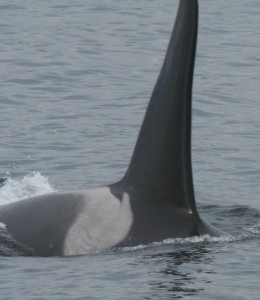
Blackberry!
The very first full day on the boat we got to encounter the whales by salmon bank! So we headed out straight away to go catch them We learned on the fly as we set in the hydrophones and scrambled for data sheets that we’d printed off for our specific projects. It was so amazing: I heard their calls as I heard them come up breathing all around us. Sound travels so brilliantly across the water, you can hear them breathe from pretty far away and still feel like they’re so close. My job was to sit with headphones on until they made calls or clicked and note when it happened, and what type of call it was. The sun was WARM on my back; another luxury I hadn’t planned on having while I was on the boat. We collected data for over three hours! And it felt like 30 minutes. We turned in to Snug Harbor and started looking at the photos at the end of the day. Both Charla and I made the same conclusion: we saw J16 (Slick) and J27 (Blackberry)!
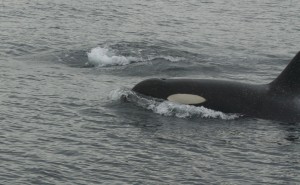
Slick!
We saw whales every day for the first three days of our trip, still learning how to do things on the go. Our first non-whale day was Charla’s birthday, the 23rd, and as close as the trampoline gets you to the water, we decided it wasn’t enough. After a CTD cast, Charla announced, “Okay, we’re jumpin in!” What peer pressure! I can’t say no to such a simple birthday wish, despite my horror to the cold rush that was about to come. But it was such a beautiful warm day! We threw our suits on and it was actually really comfortable out in the sun. And we jumped in! Into 700 feet of water. I felt so small. We swam underneath the Gato, and it was actually quite refreshing after not showering for 5 days.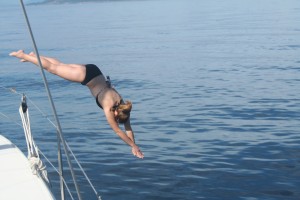
We were locked into Snug Harbor for the majority of the next day due to fog, but when we finally got out, the most incredible thing happened: for the first time of the trip, we got to experience dall’s porpoises riding our bow! We all laid on our bellies at the end of the trampoline and looked over the bow; if I wanted to, I felt like I could reach down and run my hand across one. You could tell that they were just as curious about us as we were about them, because every so often they’d lean far over on their sides and take a look at us. It was a pleasant end to a relatively uneventful day.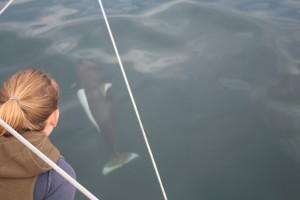
The next couple of days, instead of being trapped by fog, we were trapped by 40 knot winds. We had sailing lessons during this time from Captain Todd (just white-board stuff of course). In the afternoon, we heard the whales were right outside the harbor, and we declared that the wind died down well enough for us to go out and take a peak! For the first time of the trip, all of my rain gear went on and we got to enjoy the whales for about a half hour. I couldn’t deploy the hydrophones unfortunately, because the waves were too high. We went to Garrison Bay for a while because it’s more sheltered than Snug for the winds that weren’t predicted to let up any time soon.
The next day, as predicted, we had 40-knot winds again, and we experienced it right in the harbor! Whales were right in Haro Straight next to us, but we were stuck. By the evening we all went to land and walked for a while at English Camp for some much needed exercise! We also watched Robin’s favorite movie in the world: Life Aquatic.
The next couple of days were data days! We ended up being able to catch the whales right away in the morning! It was great getting back into the groove after a few storm days of storm. I guess we’re really lucky, EVERY day that we’ve had good weather we’ve been able to be with the whales for a while! I think I got some amazing recordings from L pod today, and we’ve been seeing mostly J’s and K’s throughout the week, so this was really exciting for me! I felt like it was like a one-time deal, and the adrenaline kicked in. Such precious data! It was a perfect closing to our first cruise. The final day I went on Soundwatch with Sharon before going back to the labs. Seven Days out of the eleven we got to be with our black and white friends, and I never felt so lucky. 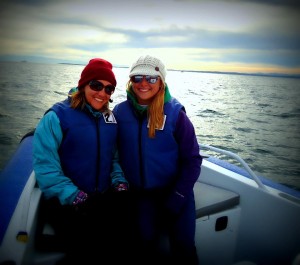
Read More
Throughout my life I’ve always seen a balance with everything. Too much of one thing is not ideal, but not having enough is not ideal either. I was looking for papers to blog about fish sustainability in our oceans, and I found an article that stated right in the abstract that there are two sides to the issue. One side sees universal failure in fisheries management and wants to use protected marine sanctuaries as the ultimate tool to try to rebuild the state of the marine ecosystems around world. This has been done in various locations around the united states with many positive results.
On the other side of the issue are people who are working in fish industries who realize that there have been numerous failures in the management of ocean fishing. But there have also been success stories, and instead of simply making sanctuaries, “This group argues that we need to apply the lessons from the successful fisheries to stop the decline and rebuild those fisheries threatened by excess fishing.â€
Worm et al. stated that if fish stocks keep declining in the same rate as they are now that the world fish stocks will collapse by 2048. With collapsed stocks, diversity of an ecosystem shatters. Worm et al. proposed that the health of a habitat is directly reliant on the diversity that it holds. They set up 32 controlled experiments as well as 12 estuarine experiments to examine the effects of variation of marine diversity of fauna and flora, resource use, and nutrient cycling. They found that increased diversity enhanced all ecosystem processes.
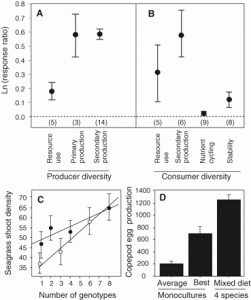
Worm et al. The graphs of Marine biodiversity and ecosystem functioning in controlled experiments.
He found that the more diversity an environment contained, the more capable it was to withstand stress; a factor quite important in these environmentally stressful times.
A proposed explanation was given to explain the advanced recovery at high diverstiy: fishers can switch more readily among target species, and therefore providing overfished species a chance to recover. By restoring biodiversity in the marine habitats through sustainable fisheries, pollution control, and the creation of marine reserves (as stated above), we can reliably invest in what our oceans provide us.
Annoyingly so, I love seafood. When you become a marine biology major, you realize how far we are away from having sustainable fisheries, and it can be quite disgruntling to discover that what you love to eat is not a sustainable food source. But now I carry a seafood watch card in my purse that was released through the Monterey Bay Aquarium.
Here at the Friday Harbor Labs we’ve had some fish for dinner here and there. Most of the selection is Tilapia, and most tilapia comes from fish farms, which is debatably sustainable. Yesterday I was surprised that King Salmon was put on the menu as our main entrée here at the labs. King salmon, also known as Chinook salmon, is considered to be a threatened species in the Puget Sound area. I thought that it was so ironic that a marine science laboratory would have that particular fish on the menu here. Although it’s endangered and threatened in many areas along the Pacific Coast, there are some sustainable practices of Chinook in certain areas, such as wild caught Alaskan salmon. Chinook salmon also happens to be the orca’s favorite type of salmon to eat.
This being said, it is vital for our endangered southern resident killer whales that we do the above suggestions: create marine sanctuaries and create regulations of fishing to maintain diversity and the ecosystem’s ability to handle stress from a rapidly altering environment. There has always been a sense of “freedom of the sea†and the idea of regulations on fish stocks is relatively new. But due to our intense fishing practices, regulations must be installed if we or other creatures depending on fish such as killer whales want to able to fish in the future, especially for the threatened King salmon.
Read More
Fish hatcheries have become ever more important in recent years due to the declines in wild stocks. The aim of hatcheries is to replenish the wild stock in order to keep the fishing industry sustainable, but there is still debate as to what is the best approach to this without causing further damage to the wild population. In an attempt to make improvements to hatchery practices, Hitoshi Araki studied the reproductive success of hatchery trout compared to wild trout, and made suggestions in his paper Hatchery Stocking for Restoring Wild Populations: A Genetic Evaluation of the reproductive Success of Hatchery Fish vs. Wild Fish (2008).
The hypothesis was that fish bred using the traditional hatchery methods, in which the fish are usually non-local and are bred for many generations in captivity, have much lower reproductive success than both supplemental hatchery fish and wild fish. The idea behind supplemental hatchery methods is to use local parent fish to breed “wild stock” hatchery fish in a protected environment, and then release them into the wild population, with the overall goal being to re-create a sustainable wild population. Using DNA analysis of steelhead trout from the Hood River, Araki determined the reproductive success of traditional hatchery fish, supplemental hatchery fish, and wild fish. He found that the more generations bred in a hatchery, the less reproductively successful the fish are.
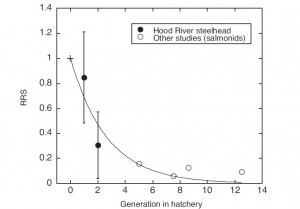
Picture 1: Araki used his own data and data from previous studies to show the decline in relative reproductive success (RRS) as the number of generations in a hatchery increased.
Araki also found that supplemental hatchery fish had significantly higher reproductive success than the traditional hatchery fish, though they still had lower reproductive success than the wild population. When a wild stock parent was crossed with a traditional hatchery parent the reproductive success dropped. This shows the effect that hatchery fish can have on the wild population. If traditional hatchery fish continue to be released into wild populations in attempt to sustain them, they will continue to lower the reproductive success of the wild population.
It seems that, though hatcheries have a positive sustainability goal in mind, the traditional methods they are using to replenish wild stocks are somewhat counter-acting what they are trying to achieve. Though it may be more work to implement supplemental hatchery methods, the benefit of higher reproductive success of the population should be worth it.
Araki used steelhead trout as his example organism, but it is assumed that similar principles could apply to other fish species. In the San Juan and Vancouver Island area, salmon hatcheries are an important part of the fishing industry (and produce important food for the Southern resident orcas!). Since Chinook salmon are endangered in the area, a large amount of juveniles are released into the wild from hatcheries. From the information I could find, it seemed hatcheries in the area are attempting to use methods closer to supplemental techniques rather than the traditional methods. For example, the San Juan Enhancement Society in Port Renfrew, BC collect their broodstock (parent fish) of Chinook from a lake connecting to the San Juan River, therefore the juvenile fish are being released into their natural habitat. Though it isn’t stated how many generations are produced in the hatchery, it still could be considered a step in the right direction compared to using a non-local broodstock. Hopefully in the future hatcheries move towards supplemental practices so that the wild stocks, the ecosystem, and everyone utilising the fish can further benefit from sustainable fish populations.
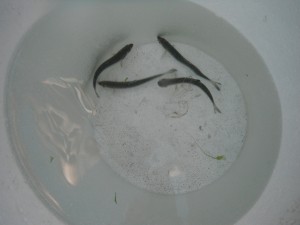 Picture 2: Both wild and hatchery juvenile Chinook can be found in the San Juan Islands, as our Beam Reach class found out while beach seining on Lopez Island. The hatchery salmon had their fins clipped for identification.
Picture 2: Both wild and hatchery juvenile Chinook can be found in the San Juan Islands, as our Beam Reach class found out while beach seining on Lopez Island. The hatchery salmon had their fins clipped for identification.
Read More
Isn’t it great having it warmer longer and being able to soak up the sun longer once summer is over?! Maybe you know the reasons from various classes or the news. Besides hearing how high CO2 levels are do you actually know how CO2 levels are affecting organisms physically? CO2 is like a fish drug that is affecting their olfactory systems and desensitizing fish to instinctive behaviors.
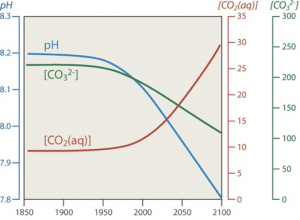 A brief background – Ocean inhabitants, especially coral reef inhabitants, are sensitive to changes whether it is temperature, CO2 concentrations, or pH. If CO2 levels continue to increase as they are, by the end of the century, there would be about 1,020ppm of atmospheric CO2 (more than enough to dramatically affect multiple marine organisms). Atmospheric and dissolved CO2 levels are linearly correlated. If atmospheric CO2 increases, dissolved CO2 in the ocean increases simultaneously. CO2 and pH levels are indirectly correlated. If dissolved CO2 increases, pH decreases. If maintaining down the current path, oceanic pH would decline up to 0.4 units, making the ocean even more acidic.
A brief background – Ocean inhabitants, especially coral reef inhabitants, are sensitive to changes whether it is temperature, CO2 concentrations, or pH. If CO2 levels continue to increase as they are, by the end of the century, there would be about 1,020ppm of atmospheric CO2 (more than enough to dramatically affect multiple marine organisms). Atmospheric and dissolved CO2 levels are linearly correlated. If atmospheric CO2 increases, dissolved CO2 in the ocean increases simultaneously. CO2 and pH levels are indirectly correlated. If dissolved CO2 increases, pH decreases. If maintaining down the current path, oceanic pH would decline up to 0.4 units, making the ocean even more acidic.
Munday et al. conducted a study to see the effects CO2 levels have on fish populations. This study was looking at clownfish and damsel fish larvae and how they respond to three different levels of CO2. The control was current CO2 levels (390ppm), 550ppm, 700ppm, and 850ppm. Behavioral responses and olfactory cues from predators were noted and it was noticed how drastic the effects of CO2 levels really were. With each increasing dosage the results were more significant. Natural and instinctive behaviors are thrown off due to the destructive influences CO2 has on the olfactory system. Instead of smelling predator cues and hiding, the increased CO2 levels cause clownfish and damsel fish to be less sensitized and alert. The fish participated in increasingly risky behavior such as spending more time where predator cues were present, swimming farther from the protections of the reef, and being more active but less alert to predator cues.
The longer a fish is exposed the worse the symptoms. Age also increased the severity of the symptoms. Noting the same change in behaviors another experiment was conducted with predator encounters. The more frequent, careless, and risky behaviors became the higher mortality rate climbed.
Not only do rising CO2 levels cause concern for species, but trying to sustain the species at risk becomes more complex. Protecting an ecosystem may no longer be enough if fish are being easily preyed upon due to the severe behavioral effects of increasing CO2 levels. Assuming other marine species will exhibit similar responses, the effects of rising CO2 on biodiversity of marine ecosystems could be significant and the effects irreversible.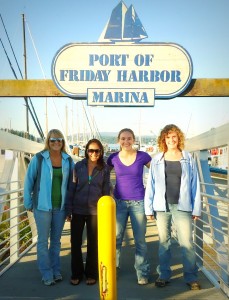
Chinook salmon are already endangered and, if the hypothesis is correct, the increasing dissolved CO2 levels could be an additional threat. Chinook, being the Southern Residents primary food source, may have a crucial impact on the killer whales if they cannot handle the added stress from rising CO2 levels. Will the Southern Residents adapt to the CO2 levels or will they suffer as much as the Chinook and other marine organisms?
The 4 students in the Fall 2011 session, along with past and future students, will study the environment and see how different factors affect the killer whales. Students are looking at relationships between the whales and salmon, human influences, and natural influences. We all start our first expedition Sunday (18th) to start collecting data for our final projects. Watch for our final projects as time moves forward!
Read More
Have you ever bought something that had a little gold sticker that said “Made in China”? I see that little sticker all over the place! Although it’s not necessarily China, but you get the idea. Of course, all this “Made in (insert country here)” stuff had to have gotten here somehow. We were asked to choose a case study in sustainability science, and the sustainability case study I chose was one about ballast water in ships (like the ships with China’s, or any other country’s, merchandise). Water gets pumped into these ships in order to stabilize it enough to make a safe journey across the oceans. After it gets pumped into ships, it’s then called “ballast water.” What people had often overlooked were the microorganisms residing in this water, such as phytoplankton, zooplankton, and small fish. These organisms get shipped hundreds of miles and get released into an entirely different ecosystem. Often these organisms die out on the journey, but every once and a while there comes a time when a nonlocal organism thrives in their new habitat. These organisms can explode in numbers uncontrollably and can sap the nutrients from the original organisms that reside there. Ballast water is like an ongoing moving infection caused by people in our oceans.
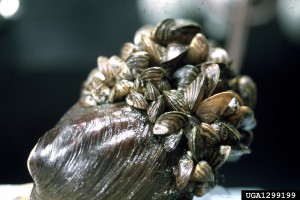
Zebra Mussel
This affects oceans everywhere. Right here in the San Juan Islands there is a bivalve invertebrate Nuttallia obscurata, also known as the purple varnish clam, that came to us through ballast water in the 1980s. The population here varies from quite rare to having up to 700 organisms per square meter. This is not just confined to our oceans; these organisms can spread to our lakes as well. Being from Minnesota, I know about the invasion of zebra mussels. They were believed to have been introduced to the St. Lawrence River in the late 1980’s. These little critters require $500,000,000 per year to control their catastrophic numbers in the Great Lakes alone. They smother local creatures, damage harbors, and need to be cleared regularly from waterways and water treatment plants.
There are different ways to go about this problem. Some have proposed sanitation standards for ballast discharge, which annihilates organisms living in the water. I asked my fellow colleagues in my Beam Reach class how they would go about this problem. Someone suggested that the ballast simply remain in the ship until it returned to its original body of water. Someone else suggested that the ballast should be dumped in the open ocean instead of the harbors. I was very happy with these comments, because they’re thinking right along the lines of John M. Drake, David M. Lodge, and Mark Lewis. They proposed diluting the release of non-indigenous species by limiting the volume of ballast water in a certain location. Spreading organisms reduces the chance of invading sexually reproducing species to flourish and expand. They also argued that the larger an organism is in a species, fewer individuals are required for an invasive blooming population, and simply a filter installed in the ballast release chambers could lower risks of bombardment. They used a reaction-diffusion model and allometric scaling to estimate a safe volume of ballast water that can be released for the smallest maximum for the types of organisms being pumped into the ships.
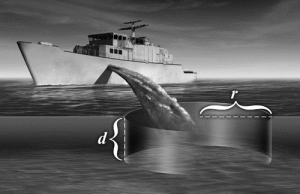 The idea is to create a population of sexually reproducing organisms that is small enough to diffuse until extinction in the area.
The idea is to create a population of sexually reproducing organisms that is small enough to diffuse until extinction in the area.
There is still a great deal of uncertainties that come with this method. Much diffusivity for certain species (or how few organisms is required for the invading species to successfully diffuse) is unknown, and would have to be researched. This method also runs under the assumption that the organisms all sexually reproduce. Dispersal is still very possible over long distances, depending on the species. There is also the foreseen problem that even if a ship were to dump the designated “safe†amount of ballast, precaution would have to be made to make sure that multiple ships weren’t releasing ballast water in the same areas.
The whole idea is to make sure that transported invasive organisms are lost to the population through diffusion faster than they can reproduce. I believe that this offers a simple alternative, and at least a start, to the incredibly impacting problem of fresh and marine habitats. I dislike how their solution doesn’t pertain to non-sexually reproducing fauna and flora, but I appreciate how realistic this temporary solution could be.
So when you buy your “Made in (insert country here)” socks, know that it’s at the cost of marine ecosystems worldwide.
Read More
A continuation of the study started in 1967 on Lake Ontario was carried out in the Great Lakes (Superior, Huron, Erie, Ontario, and Michigan) to determine the species and abundance of crustaceans and zooplankton during the summer months. Summer was chosen because it is the period when all of the Great Lakes reach maximum temperature and production. This
study focuses on the relationship between temperature and lake eutrophication. Eutrophication occurs when nitrogen and phosphorous levels are increased. The increase in nitrogen and phosphorous levels accelerates the growth of algae and
plants which deplete both oxygen levels and biodiversity.  A general trend was seen in oligotrophic (water poor in dissolved nutrients and rich in dissolved oxygen) Lake Superior to eutrophic Lake Erie. The trend occurring is a significant decrease
of Calanoids and an increased predominance of cyclopoids and cladocerans. This trend raises significant concerns because
calanoids take in energy from phytoplankton and algae, and repackage it for food consumption, making it an intricate part of the food web. In addition to the depletion of calanoids, an increase of cyclopoids and cladocerans (small crustaceans, or fresh water fleas) causes great concern as well. While the Great Lakes show different degrees of progressing eutrophication, previous
limnological studies show a number of pronounced changes in the chemistry and biology in some of these lakes over the past 60 years.
According to Patalas, K., the most significant factor determining the degree of eutrophication is due to human populations inhabiting the basin. While the increased number of species common to all the Great Lakes may be the result of a similar postglacial history of the lakes, this study concludes that differences in total abundance of certain species could be a reflection of the present morphological differences in chemical conditions. It further concludes that human influences on chemical conditions have a greater effect on eutrophication than physical conditions, such as temperature. The phosphorous loading in these lakes
affects nutrient loading. It was determined that removing phosphorous from detergents would decrease the total phosphorous loading by 0.5g/m2. Approximately 60% of phosphorous loads come from the detergents that humans use, and a drastic reduction of phosphorous is necessary to expect some apparent changes in the clarity of the water.
While it may seem that lake eutrophication is only a problem for the ecosystem of a particular lake that is being affected, this is
untrue. Not only does the crash of one ecosystem destroy the life that it once sustained, but it has devastating effects on surrounding, and interconnected ecosystems alike. Because the great lakes form a chain connecting them to the St. Lawrence River which leads to the Atlantic Ocean, the decline of species like calanoids in these lakes has an adverse effect on many animals including baleen whales, bowhead whales, right whales, and fin whales which consume them. It is important to remember that
every environment plays a unique and important role in the intricate and delicate web of life; which is why it is crucial to protect and maintain all natural environments.
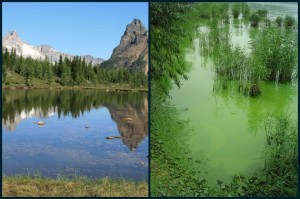
This picture compares a nice clean lake (left), to one which is highly eutrophic (right). I think you get the picture!
Read More
Once discussing sustainability science with the class and writing the previous blog about what sustainability science is I found a case study, which encompasses the sustainability of coral reefs and marine ecosystems.
People love to view the beautiful and rare ecosystems around the world, the mystery of a rainforest or the beauty of marine reefs. However, the constant tourism and destruction is destroying these rare ecosystems; but I’m focusing on the Abore Reef reserve in New Caledonia. Doyen et al. researched how over exploited marine ecosystems can be sustained by being transformed into a protected area (2007). In summary, reserves are very beneficial because they restore fisheries, ecosystems, and conserve biodiversity.
According to the National Research Council (NRC) and the National Academy of Sciences (NAS) the last 10 years spent developing ideas about sustainable science have been influenced more by political rather than scientific perceptions (1999). The economical benefits tend to cause complications for scientific purposes. However, marking a location a protected area shows a positive effect with results of increased fish size, abundances of spawning, and surrounding the reserve having increased spillover of recruited stages and larval dispersion (Doyen et al. 2007). The coral reef ecosystem is one where many organisms use the coral for shelter and sanctuary from predators so when the reef is negatively affected the whole ecosystem suffers.
Major constrains to marine ecosystems, such as coral reefs, are over exploitation and harsh weather, such as cyclones. Cyclones increase oscillations of coral and trophic densities in relation to the refuge effect. Increased cyclone frequencies cause concerns with organism interactions which could lead to trophic cascades. The effects of various cyclone frequencies are demonstrated in figure 1 below.
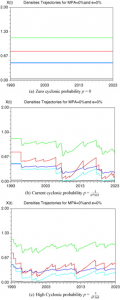
Figure 1
Time in this figure is for the next 30 years if there were no fishing efforts. The top graph (a) is if no cyclones occur, middle graph (b) a cyclone every 6 years, and the bottom graph (c) a cyclone every 4 years. The black line indicating piscivores, dark blue-carnivores, green-herbivores, light blue-small prey, red-coral state.
When looking at reefs under current cyclonic frequencies (1 cyclone every 6 years) with 20% harvesting efforts and a reef that is not protected results are similar showing carnivores and herbivores will flat line.  However, with a protected coral reef there is a much higher recovery rate because the biodiversity is significantly better. If the cyclone frequency was to increase (1 cyclone every 4 years) with 20% harvesting efforts and a coral reef is not protected carnivores and herbivores would be over exploited leading to a significant decrease in recovery rate due to a drop in biodiversity. If a coral reef is under protection the biodiversity would be good and the ecosystem would have a higher recovery rate.
After discussing case studies the class took a trip to Lopez Island to assist with some research being conducted on juvenile Chinook salmon. 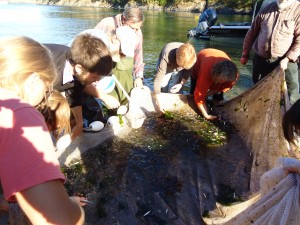 Beam Reach students along with local volunteers congregated to assist in bringing in the net once it was filled with fish. We collected sand lance, juvenile Chinook, and herring. The Chinook were sedated and then underwent a process called a lavage. Measurements of individual fish were taken, stomach contents preserved, quantity of each species noted, and tail clips for future fin biopsies. This picture shows the group of us picking out the desired fish from the second haul (3 hauls are allowed in one day’s efforts). The continued research conducted on Lopez Island and surrounding areas helps to sustain the endangered Chinook salmon population along with the organisms below (sand lance) and above (killer whales) in the food chain.
Beam Reach students along with local volunteers congregated to assist in bringing in the net once it was filled with fish. We collected sand lance, juvenile Chinook, and herring. The Chinook were sedated and then underwent a process called a lavage. Measurements of individual fish were taken, stomach contents preserved, quantity of each species noted, and tail clips for future fin biopsies. This picture shows the group of us picking out the desired fish from the second haul (3 hauls are allowed in one day’s efforts). The continued research conducted on Lopez Island and surrounding areas helps to sustain the endangered Chinook salmon population along with the organisms below (sand lance) and above (killer whales) in the food chain.
 The data in the case study and ongoing research on Lopez clearly demonstrate how key sustainability science is to preserving life in various ecosystems. It is not only about one organism or species, but the pressures people put on ecosystems as well as how different organisms interact with one another. Between the case study and research on Lopez people are discovering new information that brings us that much closer to understanding the various levels of the food chain and the ecosystem (shown in the picture to the left).
The data in the case study and ongoing research on Lopez clearly demonstrate how key sustainability science is to preserving life in various ecosystems. It is not only about one organism or species, but the pressures people put on ecosystems as well as how different organisms interact with one another. Between the case study and research on Lopez people are discovering new information that brings us that much closer to understanding the various levels of the food chain and the ecosystem (shown in the picture to the left).
Read More
After working out what sustainability science is, and all of the different fields it incorporates, I chose to focus on the fishing industry and what attempts it is making to be on a sustainable path, after large declines in many fish stocks, as my case study example. I chose a paper by Daniel Pauly et al. called Towards Sustainability in World Fisheries (Nature, 2002). This article reviews the practices of the fishing industry in the past, what they have begun to do to achieve sustainability, and what is needed in the future to try to enforce sustainability practices.
In the 1950s and 1960s, the fishing industry began growing rapidly around the world. Within 10 to 15 years of this rapid growth, and increase in government encouragement to make more catches, public examples of fish stocks crashing began to surface. What I found shocking while reading this paper was that, even though there were clear examples of depletions in fish populations (ie. cod populations in eastern Canada), the fishing industry had already become so huge that there was always an acceptable excuse to let fishing continue in the same manner around the world. Often times declines were blamed on “unspecified environmental change”, and it was also recently discovered that the People’s Republic of China had been over-reporting their catches, changing the statistics of how much global fish stocks had been declining since approximately the 1980s.
Since fishing became a large global industry, there has been some sort of monitoring of the fish stocks, in some attempt to preserve sustainability. Single-species assessments were traditionally being used and more sophisticated versions are still in practice, but as Pauly et al. explained, there have been some flaws in this approach which have led this system to fail. The problems include underestimating the severity of stock declines, and the failure to put short-term management of the stocks in place. There are also other impacts that the fishing industry is having that have not fully been taken into account when putting sustainability management in place. Depletion of the target fish species is also having an impact on the rest of the ecosystem.  Food webs in the marine environment are being disrupted with the removal of species in the mid-trophic levels, and rather than focusing on single species, ecosystems as a whole should be considered when working on sustainability management. There is also an issue with “overcapitalization” of fisheries, partly due to allowing increase in fishing vessel size, governments paying subsidies to fishers, and different types of fisheries with different rules that are not being closely monitored.
As more of the issues with the fishing industry have come to light, there has been a bigger focus on aquaculture (ie. fish farms) which many believe could be the solution to depleted wild fish stocks, but Pauly et al. point out some potential issues with this solution aswell. I was surprised to learn that aquaculture operations are actually using a lot of natural resources, and even more surprised to learn that they are even using wild stock fish to operate. Some aquaculture operations fatten their carnivorous fish with fish meal, which is actually made out of ground up fish such as herring!
Unfortunately, it seems to me that the fishing industry is still headed towards an unsustainable and grim future after reading the majority of this paper, but Pauly et al. do provide some hope near the end. Though there is still a lot of work to be done from a management standpoint, Marine Protected Areas (MPAs) that have a “no-take” policy have already shown to help increase depleted fish stocks that fuel the fishing industry. This is shown in the image below where Pauly et al. are comparing unexploited fish stocks with exploited stocks with and without no-take reserves. There are now fish scientists working feverishly around the world to gather data and plead their case for MPAs to be set up and well protected. 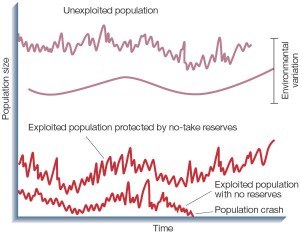
A maybe less likely goal is to begin downsizing and decomissioning some commericial fishing fleets so that there is simply less fishing occuring. Since the demand for fish is so high, this would be a hard plan to begin implementing, but it deserves serious consideration in the future if the fish stocks continue to decline.
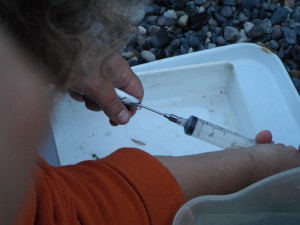 This week my classmates and I were fortunate enough to get a glimpse into the world of fish research when we helped out a group studying the endangered chinook salmon population in the San Juan area. This fit in perfectly with my case study since the chinook stocks are very low, and they are also being hatched in hatcheries to try to improve the stocks (we managed to catch one hatchery fish, which are marked before they are released). The data being collected included a fin biopsy and preserving the stomach contents to analyze what the juveniles are eating. This is the type of biological research the makes a large contibution to sustainability science and gives hope to the future of global fish stocks.
This week my classmates and I were fortunate enough to get a glimpse into the world of fish research when we helped out a group studying the endangered chinook salmon population in the San Juan area. This fit in perfectly with my case study since the chinook stocks are very low, and they are also being hatched in hatcheries to try to improve the stocks (we managed to catch one hatchery fish, which are marked before they are released). The data being collected included a fin biopsy and preserving the stomach contents to analyze what the juveniles are eating. This is the type of biological research the makes a large contibution to sustainability science and gives hope to the future of global fish stocks.
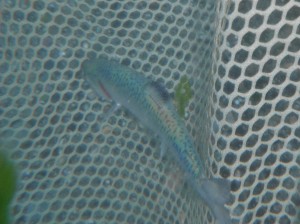
Read More
What exactly is sustainability science, and why is it important? According to the United States Environmental Protection Agency (EPA), sustainability is societies ability to meet its current needs in addition to protecting the ability of subsequent generations to meet their own needs. Individuals in society seem to understand the importance of securing resources not only to satisfy their current needs, but also the future needs of their descendants. As individuals and family units, the value of sustainability is immeasurable. Parents and grandparents alike safeguard resources needed to provide adequate care to meet the demands of their offspring. As a society however, we often ignore the impact that our decisions have on those immediately around us, as well as worldwide. This encompasses not only the impact societies decisions have on the human population, but all creatures that share the earths resources with us.
Science is defined as systematic knowledge of the physical or material world gained through observation and experimentation. Throughout the last few decades it has become increasingly evident that in order for society to maintain the luxuries and lifestyles it has grown accustomed to, it must defend the environment in which it occupies. Through exploiting minerals, plants, water sources, and animals; we often destroy our most precious and valuable resources. As we continue to gain knowledge about the world around us, it is palpable that sustainability is a science. Sustainability science requires discipline, and understanding about an ever-changing world and all of it’s components.  Through understanding, defending, and caring for the resources we often take for granted, we protect the ability of subsequent generations to meet their own needs.  It is obvious that sustainability science is essential to ensuring the survival and success of all populations.
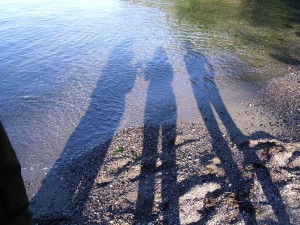
If we do not practice sustainability science now, where will we be in the future?
Read More
On the first day of Sustainability Science class, we were asked what exactly sustainability science was. I confidently wrote down in my notebook: “A way to conduct scientific studies that involves little or no disturbance to the surrounding fauna and flora while effectively collecting data usable for quantifiable research.†I pretty much thought that sustainable science was a way of collecting data without disturbing, polluting, or impacting the natural surrounding wildlife. And since we’re using a sailing catamaran, the Gato Verde, that runs on biodiesal and can generate its own power, further confirmed in my mind my definition of sustainability science. After saying this out loud, every other person in the room (including the professors) defined sustainability science through the problems being addressed, such as energy crisis, toxic atmospheres and oceans, and high CO2 levels, and finding a way to combine the sciences into one (sustainability science) to solve these problems. It is the knowledge that ultimately moves toward a place where humans and the environment can coexist comfortably.
Right now I think that’s the obvious definition. But at the time I was thinking about my Deep Sea Conservation class that I had taken at Eckerd College the previous winter term. I distinctly remember an article that my professor had us read, and it was about observing deep-sea fauna next to hydrothermal vents. They noticed that the deep-sea shrimp being observed by the vents with bright lights were actually blinded by the intensity of the lights, and the shrimp by the vents that weren’t exposed to the light showed no signs of disturbance. Physical harm resulted from scientific inquiry. The same goes for trawling in the oceans. Trawling is corrosive and can be detrimental for long periods of time following the trawl. The amount of knowledge obtained by such practices can be seen positively, but such a destructive way to go about research has one wondering whether or not we as scientists are helping or contributing to the problem.
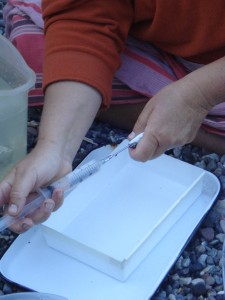
Fig. 1. The semi-invasive of a stomach lavage done on a juvenile Chinook Salmon on Lopez Island, August 27th, 2011.
On the 27th of August, we “Beamers†and Robin just went to Lopez Island to go fishing, and I honestly didn’t know what to expect. Were we catching and releasing? Were we going to just see what we caught and chart the amounts of each species we saw? Were we catching dinner? It turned out that we were actually going to observe the capture of juvenile Chinook salmon. Salmon here is considered a keystone species, meaning that it plays a major role in the entire ecosystem. Here, it’s a major prey item to a wide diversity of creatures, which includes orcas, bears, pinnipeds, and large birds of prey. And hey, people find them tasty as well. With these salmon they performed a stomach lavage, which is pretty much flushing the stomach of its content to see what they prefer to eat.
With Chinook holding an endangered species status, they had to take every precaution to avoid fatalities with the fish. At .5% mortality, I’d say that they’re doing quite well. This practice is considered to be “semi-invasive,†one that I personally believe is worth investigating if it means that we’ll have hard evidence of what is causing these very important fish to struggle as a species, and what would need to be done to help it make a come-back.
Looking at the different definitions of sustainability science that occurred, I must say that perhaps they are all accountable. It is a science that moves us forward to a sustainable planet, and it’s also a science that should be as non-invasive as possible. Analyzing the wide spectrum of invasive practices, as a young scientist, I realize that there is a fine line between conducting strictly non-invasive research, and doing so much research that scientists themselves have an impact on the ecosystems of the planet. It’s a very opinionated topic, and a scientist in these environmentally stressful times must justify how much they’re willing to impact the environment being studied in order to gain the proper amount of knowledge to contribute to a sustainable world.
Read More
























 Twitter
Twitter LinkedIn
LinkedIn Facebook
Facebook